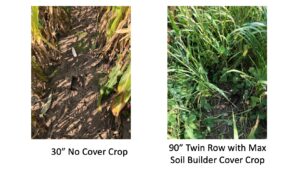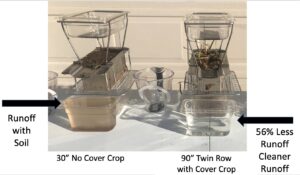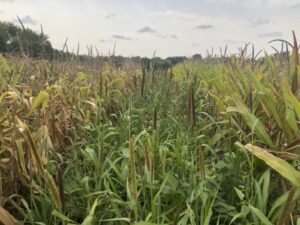Project Overview
Information Products
Commodities
- Agronomic: corn
Practices
- Crop Production: cover crops, double cropping
- Education and Training: on-farm/ranch research
Proposal summary:
Cover Crops are known to improve soil and water quality, but adoption has been slower than desired. My 2021/2022 SARE Project, referred above, provided an opportunity for side by side comparison of 30” corn with no cover crop vs. 90” Twin Row corn with an aggressive multi-species cover crop mix. Samples from those plots demonstrated a 56% reduction in water runoff, based on four replications. Equally importantly, the runoff water was cleaner. This project enables demonstration on more grower-owned plots with side-by-side replicated trials of various cover crop treatments. Ref imagery from 2021 below:
A key element of this work is for the plots to demonstrate alternative treatments on the grower's own property. For the results to be credible to the grower, the alternative practice should be compared directly to traditional practices. This is important to demonstrate any changes in cash crop yields, weed pressure, runoff water, and nutrient requirements. The risk to the grower's operations can be minimized by using small equipment to create small plots. This grant enables efficient and quick seeding of small plots with small equipment in grower fields, and provides measurement/demonstration equipment for end of season environmental impact information in additional to traditional yield measurements.
Project objectives from proposal:
- Compare cover crop vigor in wide (60 or 90") row corn plots on grower property vs. cover crop planted in traditional (20 or 30") rows.
- Document early season cover crop growth vs cash crop.
- Document differences in early, mid, and late season weed suppression in the various treatments.
- Measure water runoff differences in wide row cover crop spaces vs traditional row spaces.
- Measure yield differences in the various replicated trial treatments.
- Record with imagery and measure differences in cover crop biomass in the various treatments.


